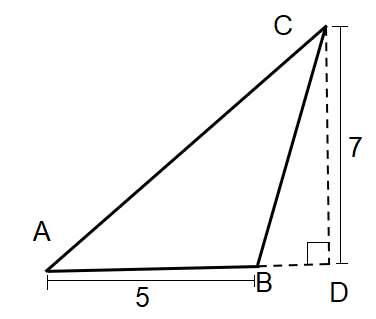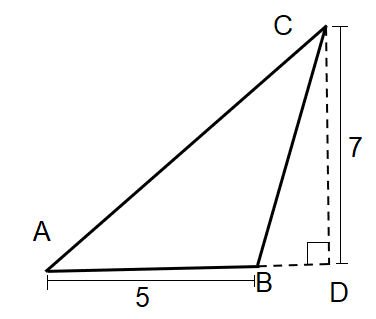
Find the area of $\Delta ABC$.

(a) $17.5c{{m}^{2}}$
(b) $16.5c{{m}^{2}}$
(c) $18.5c{{m}^{2}}$
(d) $12c{{m}^{2}}$

Answer
506.1k+ views
Hint: We first form the area of $\Delta ABC$ as $ar\left( \Delta ABC \right)=ar\left( \Delta ACD \right)-ar\left( \Delta BCD \right)$. We take the right-angle triangles and find their areas. We subtract them to find the area of $\Delta ABC$.
Complete step-by-step solution:
The given $\Delta ABC$, has a height of 7 cm.

We take the perpendicular point from point C on extended AB as D.
We assume the area of $\Delta ABC$ as $ar\left( \Delta ABC \right)=ar\left( \Delta ACD \right)-ar\left( \Delta BCD \right)$
As the $\angle ADC={{90}^{\circ }}$, therefore we can take both $\Delta ACD$ and $\Delta BCD$ as right-angled triangles.
The height for both of them will be $CD=7$.
Now let us assume the length $BD=a$. Therefore, $AD=AB+BD=5+a$.
Now we find the areas. The formula is half of the multiplication of the sides holding the right-angle.
For $\Delta ACD$, the area is $\dfrac{1}{2}\times AD\times CD=\dfrac{7\left( 5+a \right)}{2}$.
For $\Delta BCD$, the area is $\dfrac{1}{2}\times BD\times CD=\dfrac{7a}{2}$.
So, $ar\left( \Delta ABC \right)=ar\left( \Delta ACD \right)-ar\left( \Delta BCD \right)=\dfrac{7\left( 5+a \right)}{2}-\dfrac{7a}{2}$.
We simplify to get \[ar\left( \Delta ABC \right)=\dfrac{7}{2}\left( 5+a-a \right)=\dfrac{35}{2}=17.5c{{m}^{2}}\].
The correct option is (a).
Note: The height is necessarily needed to be inside the figure. The height on the extended line is also the height of the figure. In that case we can take the area for $\Delta ABC$ as $\dfrac{1}{2}\times AB\times CD=\dfrac{35}{2}$.
Complete step-by-step solution:
The given $\Delta ABC$, has a height of 7 cm.

We take the perpendicular point from point C on extended AB as D.
We assume the area of $\Delta ABC$ as $ar\left( \Delta ABC \right)=ar\left( \Delta ACD \right)-ar\left( \Delta BCD \right)$
As the $\angle ADC={{90}^{\circ }}$, therefore we can take both $\Delta ACD$ and $\Delta BCD$ as right-angled triangles.
The height for both of them will be $CD=7$.
Now let us assume the length $BD=a$. Therefore, $AD=AB+BD=5+a$.
Now we find the areas. The formula is half of the multiplication of the sides holding the right-angle.
For $\Delta ACD$, the area is $\dfrac{1}{2}\times AD\times CD=\dfrac{7\left( 5+a \right)}{2}$.
For $\Delta BCD$, the area is $\dfrac{1}{2}\times BD\times CD=\dfrac{7a}{2}$.
So, $ar\left( \Delta ABC \right)=ar\left( \Delta ACD \right)-ar\left( \Delta BCD \right)=\dfrac{7\left( 5+a \right)}{2}-\dfrac{7a}{2}$.
We simplify to get \[ar\left( \Delta ABC \right)=\dfrac{7}{2}\left( 5+a-a \right)=\dfrac{35}{2}=17.5c{{m}^{2}}\].
The correct option is (a).
Note: The height is necessarily needed to be inside the figure. The height on the extended line is also the height of the figure. In that case we can take the area for $\Delta ABC$ as $\dfrac{1}{2}\times AB\times CD=\dfrac{35}{2}$.
Recently Updated Pages
Master Class 9 Social Science: Engaging Questions & Answers for Success

Master Class 9 Science: Engaging Questions & Answers for Success

Master Class 9 English: Engaging Questions & Answers for Success

Master Class 9 Maths: Engaging Questions & Answers for Success

Master Class 11 Economics: Engaging Questions & Answers for Success

Master Class 11 English: Engaging Questions & Answers for Success

Trending doubts
What is the Full Form of ISI and RAW

Golden Revolution is related to AFood production BOil class 9 social science CBSE

Which is the longest day and the shortest night in class 9 social science CBSE

Which are the Top 10 Largest States of India?

Why did Aurangzeb ban the playing of the pungi Answer class 9 english CBSE

Distinguish between the following Ferrous and nonferrous class 9 social science CBSE




